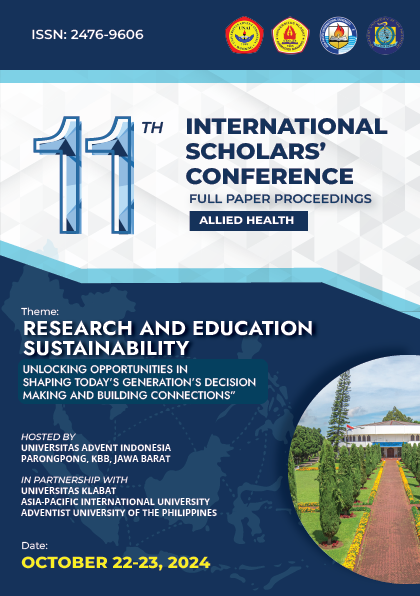A Systematic Review on Stress and Coping Strategies of Nursing Students
Keywords:
reviewAbstract
Stress is a pervasive phenomenon that impacts people’s emotional and professional well-being, as well as their physical and mental health. It affects the retention and patient outcomes of care. It has also severely affected healthcare finances. McCarthy et al. (2018) stated that although stress is an unavoidable aspect of academic life, not all stress is bad. This qualitative study on Systematic Review of Stress and Coping Strategies aims to identify sources and levels of stress experienced by undergraduate nursing students and their employed coping strategies. Review analyses of the 25 relevant studies published between 2016 and 2023 through database selection, securing credible access to academic databases containing medical literature and Francis Online, ResearchGate, ScienceDirect, Cochrane Library, and EBSCOhost. Common stressors shifted based on the student year. Three primary stressors were identified: heavy workloads, negative interactions with clinical instructors and healthcare staff, and patient care concerns, including fear of mistakes. Interestingly, fourth-year heaviest workloads; second- and third-year students identified patient care concerns; and most of the studies indicated that participants experience moderate to high levels of stress during initial clinical placements and exposure to the healthcare environment. Participants employed varied coping strategies, such as focused coping, problem-solving strategies, emotion-focused strategies, a combination of problem-focused and emotion-focused strategies, and avoidance coping. This study aims to address students’ sources of stress, enhance workload management and communication skills, and promote healthy coping mechanisms through workshops for participants to not only cope with stress but thrive amidst the different challenges of nursing life.
Downloads
References
Al-Gamal E, Alzayyat A, Ahmad MM. Prevalence of Internet Addiction and Its Association With Psychological Distress and Coping Strategies Among University Students in Jordan. Perspectives in Psychiatric Care. 2016;52(1):49-61. doi:10.1111/ppc.12102
Anbumalar C., Dorathy A. P., Jaswanti V.P., Priya D., Reniangelin D. (2017). Gender Differences in Perceived Stress levels and Coping Strategies among College Students. The International Journal of Indian Psychology. 2017;4(4). doi:10.25215/0404.103
Auerbach, R. P., Alonso, J., Axinn, W. G., Cuijpers, P., Ebert, D. D., Green, J. G., ... & Bruffaerts,R. (2016). Mental disorders among college students in the World Health Organization world mental health surveys. Psychological medicine, 46(14), 2955- 2970.
August, R.and Dapkewicz A. (2021). Benefit finding in the COVID-19 pandemic: College students’ positive coping strategies. Journal of Positive School Psychology. :5(2);73-86. doi:10.47602/jpsp.v5i2.245
Coiro MJ, Bettis AH, Compas BE. (2017) College students coping with interpersonal stress: Examining a control-based model of coping. Journal of American College Health. 2017;65(3):177-186. doi:10.1080/07448481.2016.1266641
Colaizzi, P. (1978). Psychological research as a phenomenologist views it. In: Valle, R. S. & King,M. Existential Phenomenological Alternatives for Psychology. Open University Press: New York.
Ganeshkumar, P., & Gopalakrishnan, S. (2013). Systematic reviews and meta-analysis: Understanding the best evidence in primary healthcare. Journal of Family Medicine and Primary Care, 2(1), 9. https://doi.org/10.4103/2249-4863.109934
Hathaway ED, Peyer KL, Doyle KA.(2023) A first look at perceived stress in southeastern university students during the COVID-19 pandemic. Journal of American College Health.;71(2):329-332. doi:10.1080/07448481.2021.1895809
Huang, L, Lei, W, Xu F, Liu, H, Yu L. (2020) Emotional responses and coping strategies in nurses and nursing students during Covid-19 outbreak: A comparative study. PloS one.;15(8):e0237303. doi:10.1371/journal.pone.0237303
Hu W, Sun M.(2023) COVID-19 Stressors and Aggression among Chinese College Students: The Mediation Role of Coping Strategies. International journal of environmental research and public health. ;20(4). doi:10.3390/ijerph20043171
Hwang E, Kim M, Shin S. (2021) Initial Clinical Practicum Stress among Nursing Students: A Cross- Sectional Study on Coping Styles. International journal of environmental research and public health. 2021;18(9). doi:10.3390/ijerph18094932
Johnson, A., Davis, M. D., Yi, R., & Horst, S. J. (2018). An exploration of stressors experienced by college students: variation by gender and ethnicity. Journal of Student Affairs Research and Practice,55(2),196-211.
Kacan CY, Pallos (2021). A. Global Problem of Nursing Students: Nursing Education Stress: A Sample From Turkey. International Journal of Caring Sciences.;14(2):1193- 1203. ttps://search.ebscohost.com/login.aspx? direct=true&db=rzh&AN= 153590747&site= ehost- live
Leombruni P, Corradi A, Lo Moro G, et al. (2022) Stress in Medical Students: PRIMES, an Italian, Multicenter Cross-Sectional Study. International journal of environmental research and public health.;19(9). doi:10.3390/ijerph19095010
Liu J, Yang Y, Chen J, Zhang Y, Zeng Y, Li J.(2022) Stress and coping styles among nursing students during the initial period of the clinical practicum: A cross-section study. International Journal of Nursing Sciences.;9(2):222-229. doi:10.1016/j.ijnss.2022.02.004
McCarthy B, Trace A, O DM, et al. (2018). Nursing and midwifery students’ stress and coping during their undergraduate education programmes: An integrative review. Nurse Education Today. 2018;61:197-209. doi:10.1016/j.nedt.2017.11.029
Onieva-Zafra MD, Fernández-Muñoz JJ, Fernández-Martínez E, García-Sánchez FJ, Abreu- Sánchez A, Parra-Fernández ML.(2020). Anxiety, perceived stress and coping strategies in nursing students: a cross-sectional, correlational, descriptive study. BMC medical education.;20(1):370. doi:10.1186/s12909-020-02294-z
Pati D and Lorusso LN.(2018). How to Write a Systematic Review of the Literature. HERD: Health Environments Research & Design Journal. 2018;11(1):15-30. doi:10.1177/1937586717747384
Pollock A, Berge E.(2018). How to do a systematic review. International Journal of Stroke. 13(2):138-156. doi:10.1177/1747493017743796
Saleh D, Camart N, Romo L. (2017). Predictors of Stress in College Students. Frontiers in psychology. 2017;8:19. doi:10.3389/fpsyg.2017.00019
Shdaifat E, Jamama A, Al Amer M.(2018). Stress and Coping Strategies among Nursing Students. Global Journal of Health Science,;10(5). doi:10.5539/gjhs.v10n5p33
Smith, B. W., Dalen, J., Wiggins, K., Tooley, E., Christopher, P., & Bernard, J. (2016). The brief resilience scale: assessing the ability to bounce back. International Journal of Behavioral Medicine, 15(3), 194-200. doi:10.1080/10705500802222972.
Taniguchi H, Kato T. (2018). The Frequencies and Effects of Interpersonal Stress Coping with Different Types of Interpersonal Stressors in Friendships on Mental Health and Subjective Well-Being among College Students. The Japanese Journal of Personality. 27(3):252-258. doi:10.2132/personality.27.3.8
Valladolid, V. C. (2021).The Role of Coping Strategies in the Resilience and Well-Being of College Students during COVID-19 Pandemic. Philippine Social Science Journal. :4(2);30-42. https://doi.org/10.52006/main.v4i2.342
Zepp, P., Potter, D., Haselwood, C., & Britt-Lutter, S. (2018). The Influence of Coping Strategies on College Students’ Grade Point Averages. Family and Consumer Sciences Research Journal.:47(1), 73–86. doi:10.1111/fcsr.12274
Downloads
Published
How to Cite
Issue
Section
License
Copyright (c) 2024 11th International Scholars Conference

This work is licensed under a Creative Commons Attribution-ShareAlike 4.0 International License.
Copyright © 2024 ISC Committee.














